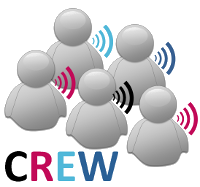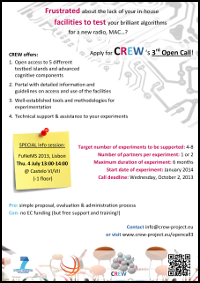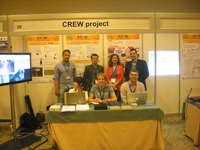September 2013
|
Dear subscriber,
|
|
The FP7-CREW (Cognitive Research Experimentation World) project is now about to finish its third year. In this issue of the CREW newsletter, you will find amongst others information about our 3rd Open Call, testimonials from the completed Open Call 1 experiments, etc .
|
Open Call 3 - reminder !!!
|
|
The CREW project organizes a third open call for experiments with cognitive radio and/or cognitive networks.
The selected experiments will benefit from extensive support and training by the CREW consortium. Prospective experimenters are invited to submit proposals before the deadline of Wednesday 2 October, 2013 (17:00 CET).
For more details, please consult the Open Call 3 page.
Information on the past two successful open calls is available, as well as demonstrations videos about the resulting experiments.
Recently, the Memorandum of Understanding has also been made available.
Go back to the top of the page.
|
Open Call 1 testimonial (1/3)
Ilmenau University of Technology
|
|
Title: CCA agent in a CSMA MAC using Iris

What is the most striking output from the experiment?
Even having a hardware-assisted CCA mechanism only (this is, the sensing engine) helps in mitigating the negative effects for random-access MAC of purely software-defined radios.
Did the experiment meet your expectations?
Yes, the experiments met our expectations.
Can you identify research gaps that must be addressed to further optimise the solution?
* The overall issue of random-access MAC implementation on state-of-the-art SDR hardware (i.e. USRP) still remains pretty much open. So this could be interesting.
* Further integration of spectrum sensing for detection of other users including ourselves and possibly other techniques on the same frequency band.
How did CREW help you?
Thanks to CREW, the Technische Universität Ilmenau could have access to state-of-the-art spectrum sensing equipment (imec sensing engine). The new coupling scheme between imec sensing engine and Iris reconfigurable SDR developed by the Technische Universität Ilmenau is now available at the iMinds facilities (w-iLab.t) for use by other experimenters.
Go back to the top of the page.
|
Open Call 1 testimonial (2/3)
Tecnalia Research & Innovation
|
|
Title: Collaborative spectrum sensing

What is the most striking output from the experiment?
* Collaborative spectrum sensing is needed in order to draw the spectrum occupation map in a reliable way.
* The data fusion solution based in a Linear Statistical Combination with Harmony Search optimization clearly outperforms the other tested ones.
Did the experiment meet your expectations?
Yes, the obtained results have proved us right in our initial hypothesis for the data fusion solution.
Can you identify research gaps that must be addressed to further optimise the solution?
* Further experimentation in an outdoor scenario are needed in order to answer the following questions:
- How many sensors per square meter are needed for an optimal sensing?
- How must be they (the sensors) deployed?
- How long should the scan period be?
* An appropriate mechanism for accessing the sensing network must be designed, i.e. how is the communication between the sensors and the decision node achieved?
* How is the information in the data base stored? In which format?
How did CREW help you?
Participation in the project has been extremely interesting and fruitful for Tecnalia. First of all, it has provided a great opportunity to test and validate some of Tecnalia’s advanced cognitive radio technical developments, which was extremely difficult without CREW. CREW has given access to advanced cognitive components like the Transceiver Facility Implementation API from Thales and the Iris reconfigurable Software Defined Radio (SDR) platform in a single set-up. Additionally, it has allowed Tecnalia to learn great lessons about testbed usage.
Go back to the top of the page.
|
Open Call 1 testimonial (3/3)
University of Durham
|
|
Title: Device sensitivity and environment measurements

What is the most striking output from the experiment?
The digital swept method is a viable solution to sensing. The direct down conversion quadrature method did not seem to have an advantage in sensing compared to the digital swept method. The latter seemed to offer a bandwidth advantage over the quadrature method with current ADC technology.
Did the experiment meet your expectations?
Yes we now have a considerable data base and system that is capable of sensing and channel measurements.
Can you identify research gaps that must be addressed to further optimise the solution?
A great deal is yet to be done such as distributive sensing with high end devices.
How did CREW help you?
Thanks to CREW, the University of Durham was able to calibrate diverse spectrum sensing hardware in different physical environments (different individual test facilities of the CREW federation). The measurements performed by the University of Durham permitted the facilities to have a better understanding of the wireless propagation properties of different physical environments, which may be beneficial for future experiments.
Go back to the top of the page.
|
Successful demos at FuNeMS
|
|
At the Future Network and Mobile Summit (FuNeMS) on 3-5 July 2013 in Lisbon, some preliminary results of the Open Call 2 experiments were demonstrated, as well as some experiments of the core partners. You were unable to attend? No worries, you can still watch these demos online.
Go back to the top of the page.
|
The CREW Training Days:
a story to be continued
|
|
On 19-20 February 2013, the first CREW Training Days took place in Brussels. They provided a lot of information and hands-on testing of the different facilities within the CREW federation. Presentations and tutorials are still available online. We thank the different attendees for their interest and their cooperation during these days! The collected feedback revealed that the vast majority found these training days very useful. Therefore, a second edition is planned on 14-15 January 2014, which will be especially very useful for new Open Call 3 experimenters.
Go back to the top of the page.
|
Other news
|
|
CREW is now also on social media. Share, like, tweet or whatever us on:
At the Future Network and Mobile Summit 2013 (FuNeMS), the Best Paper Award 2013 went to Pierluigi Gallo, Domenico Garlisi, Fabrizio Giuliano, Francesco Gringoli, Ilenia Tinnirello and Giuseppe Bianchi (CNIT) for their paper "A Control Architecture for Wireless MAC Processor Networking", supported by the FLAVIA and CREW project. Congrats to the authors!
The paper "Supporting a Pseudo-TDMA Access Scheme in Mesh Wireless Networks" by I. Tinnirello and P. Gallo, which was supported by the CREW project, received the best paper award at WiFlex 2013, Kaliningrad, Russia.
We look also forward to meeting you at an upcoming conference or event.
Best regards,
The CREW project
Go back to the top of the page.
|



